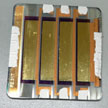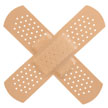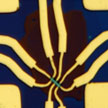Showing Spotlights 1097 - 1104 of 2876 in category All (newest first):
 Previously reported conductive self-healing materials usually need large amounts of inorganic conducting fillers and their self-healing behaviors are only activated under specific external stimuli, such as heat, light, pH, etc. A new hybrid gel is composed of conductive polymer and a metal-ligand supramolecule; the novel gel exhibits attractive properties associated with both conventional polymers, such as ease of synthesis and processing, and great self-healing performance at room temperature without any stimuli.
Previously reported conductive self-healing materials usually need large amounts of inorganic conducting fillers and their self-healing behaviors are only activated under specific external stimuli, such as heat, light, pH, etc. A new hybrid gel is composed of conductive polymer and a metal-ligand supramolecule; the novel gel exhibits attractive properties associated with both conventional polymers, such as ease of synthesis and processing, and great self-healing performance at room temperature without any stimuli.
Aug 25th, 2015
 For the past decade, researchers have searched for robust, inorganic color filters that can replace traditional organic dye-based filters for better stability, lifetimes, performance, and amenability to miniaturization. I new work, researchers fabricated an inorganic filter that can operate with a single element. This represents an important step toward nanoscale color filters. The team devised a a simple design in which light can be filtered and tuned over wavelength through the use of a single nanoscale element in the form of a ZnO nanorod integrated with a silver cavity.
For the past decade, researchers have searched for robust, inorganic color filters that can replace traditional organic dye-based filters for better stability, lifetimes, performance, and amenability to miniaturization. I new work, researchers fabricated an inorganic filter that can operate with a single element. This represents an important step toward nanoscale color filters. The team devised a a simple design in which light can be filtered and tuned over wavelength through the use of a single nanoscale element in the form of a ZnO nanorod integrated with a silver cavity.
Aug 13th, 2015
 Glass is notorious for its brittleness. Although industry has developed ultra-thin, flexible glass that can be bent for applications liked curved TV and smartphone displays, fully foldable glass had not been demonstrated. Until now. In new work, researchers have demonstrated substrate platforms of glass and plastics, which can be reversibly and repeatedly foldable at pre designed location(s) without any mechanical failure or deterioration in device performances.
Glass is notorious for its brittleness. Although industry has developed ultra-thin, flexible glass that can be bent for applications liked curved TV and smartphone displays, fully foldable glass had not been demonstrated. Until now. In new work, researchers have demonstrated substrate platforms of glass and plastics, which can be reversibly and repeatedly foldable at pre designed location(s) without any mechanical failure or deterioration in device performances.
Aug 11th, 2015
 The development of perovskite solar cells, first reported in 2009 (and with a record power conversion efficiency of 20.1 percent so far), is a possible route towards high efficiency photovoltaics that are also cost-effectiveness, owing to to their easy-processing from solution. Question marks have however remained on their stability. Now, researchers report the world's first nanorod-based perovskite solar module. In addition to high efficiency, these perovskite solar modules also show remarkable and improved shelf life.
The development of perovskite solar cells, first reported in 2009 (and with a record power conversion efficiency of 20.1 percent so far), is a possible route towards high efficiency photovoltaics that are also cost-effectiveness, owing to to their easy-processing from solution. Question marks have however remained on their stability. Now, researchers report the world's first nanorod-based perovskite solar module. In addition to high efficiency, these perovskite solar modules also show remarkable and improved shelf life.
Aug 7th, 2015
 Wrinkling and buckling can occur at all length scales in materials composed of a stiff thin film on a strained supporting layer. When the strain is removed, either by thermal or mechanical stimuli, different surface patterns can form. This phenomenon - now starting to be realized at nanometer length scales - is emerging as a powerful bottom-up nanopatterning method to program surfaces with unique properties. It has many applications in the design and fabrication of flexible electronics and devices, micro-cell arrays, optical gratings, and so on.
Wrinkling and buckling can occur at all length scales in materials composed of a stiff thin film on a strained supporting layer. When the strain is removed, either by thermal or mechanical stimuli, different surface patterns can form. This phenomenon - now starting to be realized at nanometer length scales - is emerging as a powerful bottom-up nanopatterning method to program surfaces with unique properties. It has many applications in the design and fabrication of flexible electronics and devices, micro-cell arrays, optical gratings, and so on.
Aug 4th, 2015
 Researchers introduced a novel self-neutralization concept by designing molecular architecture of a block copolymer to develop vertically oriented lamellar or cylindrical nanodomains without pre- or post-treatments. Previously, in order to induce vertical orientation of block copolymer nanodomains in the film state, diverse pre- or post-treatments to neutralize the preferential affinity between a substrate and each block of the block copolymer need to be introduced
Researchers introduced a novel self-neutralization concept by designing molecular architecture of a block copolymer to develop vertically oriented lamellar or cylindrical nanodomains without pre- or post-treatments. Previously, in order to induce vertical orientation of block copolymer nanodomains in the film state, diverse pre- or post-treatments to neutralize the preferential affinity between a substrate and each block of the block copolymer need to be introduced
Aug 3rd, 2015
 Skin thermal burns are a complex and major source of morbidity, mortality and healthcare expenditure. Given the range of causes, from fire associated injury to water scalding, patients often present with multiple and complex burns - wounds that often worsen and expand over the first few days do to the associated underlying inflammation and injury. To facilitate better wound healing, researchers have developed nanoparticles that can both release the potent biomolecule nitric oxide (NO) over time, as well as facilitate nitrosation, the addition of an NO group to a biological molecule, which is central many of NO's activity.
Skin thermal burns are a complex and major source of morbidity, mortality and healthcare expenditure. Given the range of causes, from fire associated injury to water scalding, patients often present with multiple and complex burns - wounds that often worsen and expand over the first few days do to the associated underlying inflammation and injury. To facilitate better wound healing, researchers have developed nanoparticles that can both release the potent biomolecule nitric oxide (NO) over time, as well as facilitate nitrosation, the addition of an NO group to a biological molecule, which is central many of NO's activity.
Jul 28th, 2015
 The noise level in devices with graphene and other two-dimensional (2D) materials has to be reduced in order to enable their practical applications. It will not be possible to build graphene-based communication systems or detectors until the noise spectral density is decreased to the level comparable with the conventional state-of-the-art transistors.Researchers have now demonstrated that the electronic noise in graphene devices can be strongly suppressed if a graphene channel is encased between two layers of hexagonal boron nitride.
The noise level in devices with graphene and other two-dimensional (2D) materials has to be reduced in order to enable their practical applications. It will not be possible to build graphene-based communication systems or detectors until the noise spectral density is decreased to the level comparable with the conventional state-of-the-art transistors.Researchers have now demonstrated that the electronic noise in graphene devices can be strongly suppressed if a graphene channel is encased between two layers of hexagonal boron nitride.
Jul 27th, 2015
 Previously reported conductive self-healing materials usually need large amounts of inorganic conducting fillers and their self-healing behaviors are only activated under specific external stimuli, such as heat, light, pH, etc. A new hybrid gel is composed of conductive polymer and a metal-ligand supramolecule; the novel gel exhibits attractive properties associated with both conventional polymers, such as ease of synthesis and processing, and great self-healing performance at room temperature without any stimuli.
Previously reported conductive self-healing materials usually need large amounts of inorganic conducting fillers and their self-healing behaviors are only activated under specific external stimuli, such as heat, light, pH, etc. A new hybrid gel is composed of conductive polymer and a metal-ligand supramolecule; the novel gel exhibits attractive properties associated with both conventional polymers, such as ease of synthesis and processing, and great self-healing performance at room temperature without any stimuli.
 Subscribe to our Nanotechnology Spotlight feed
Subscribe to our Nanotechnology Spotlight feed





